At A Glance
Holiday shopping in 2025 doesn’t follow one clear pattern, with shoppers blending early planning and last-minute purchases, digital discovery and in-store validation, and cautious spending. Marketers who embrace this complexity, by staying relevant, consistent, and connected across channels, will be best positioned to win this season.Holiday shopping in 2025 feels a lot like a complicated relationship. Shoppers want deals, but they also want trust. They start shopping early, but they’re still browsing well into December. They love the convenience of online shopping, but they still show up in-store before making the final call.
Our 2025 Holiday spending trends and insights report, created this year in collaboration with GroundTruth, explores these contradictions. Our findings show that this year’s holiday season isn’t about one big shift; it’s about managing the push and pull between what consumers say, what they do, and how marketers respond.
Here are three complicated truths you need to know.
Experian’s 2025 Holiday spending trends and insights report
Optimize your 2025 holiday shopping campaigns with our latest report with GroundTruth.
Download now1. The new rules of holiday timing
Almost half (45%) of consumers plan to start shopping before November, but 62% admit they’ll still be buying in December. And post-holiday shopping (think gift card redemptions and deal-hunting) remains a real factor.
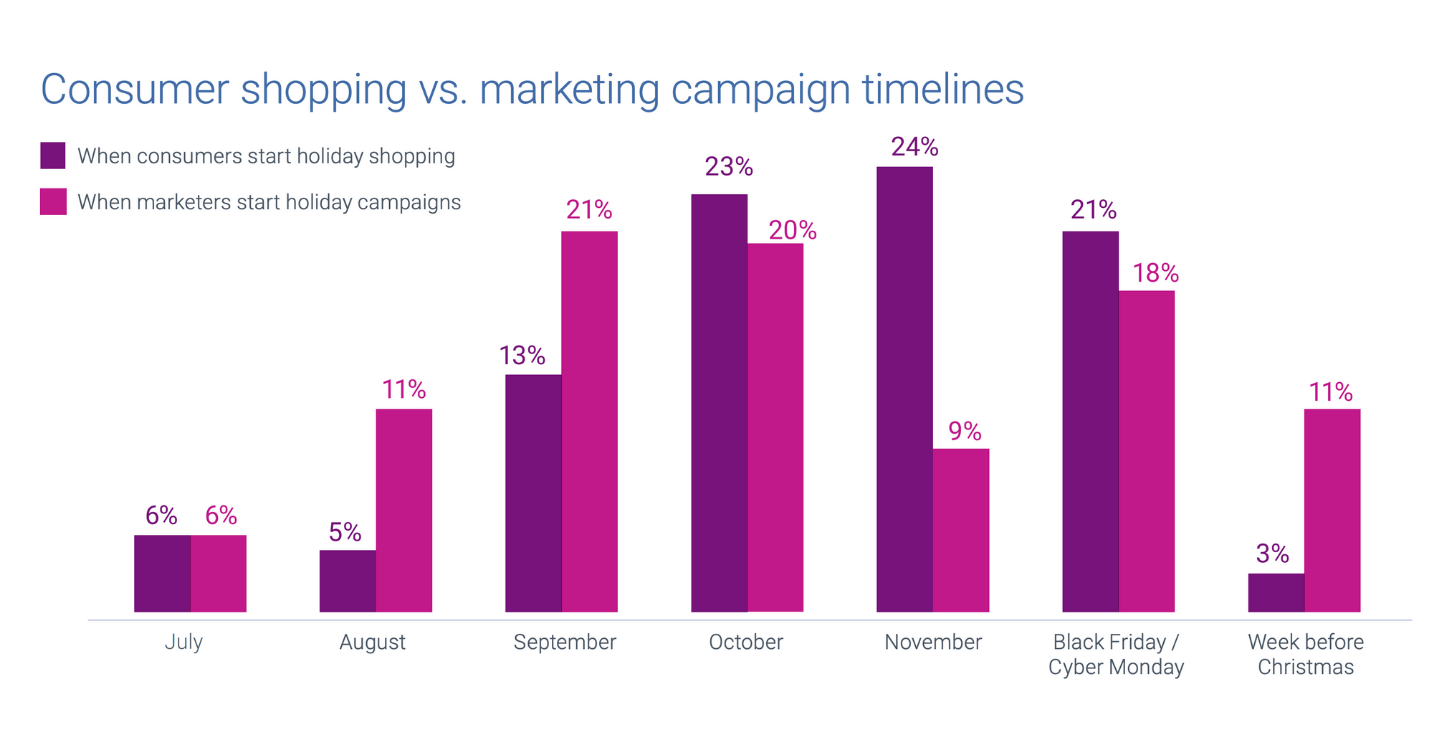
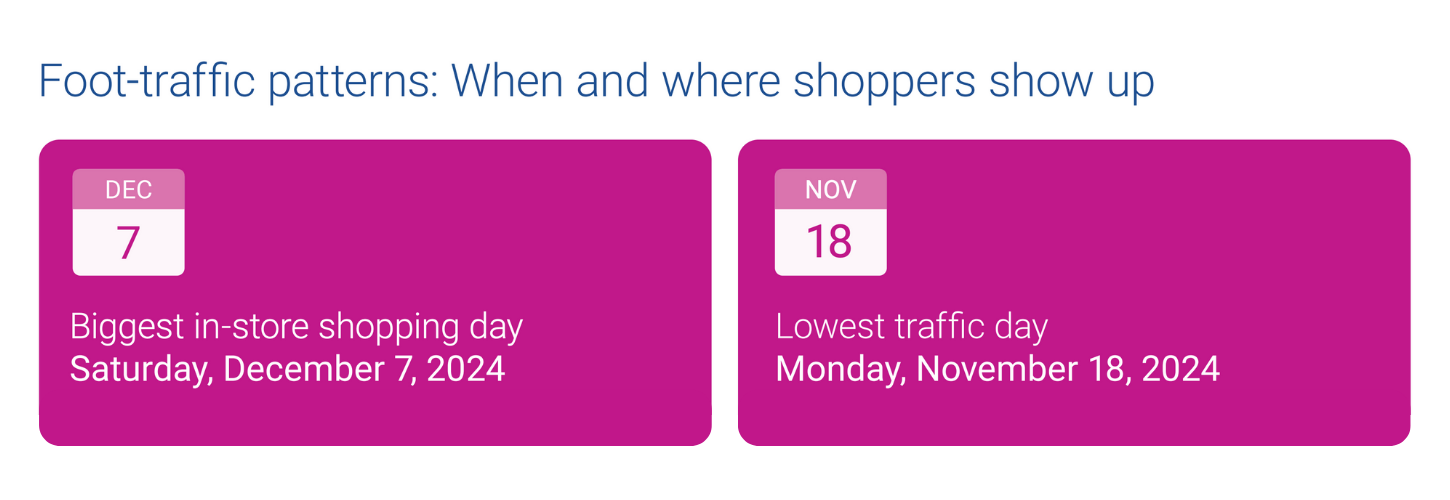
Why it’s complicated
The holiday calendar isn’t what it used to be. There’s no single “big moment” anymore. Instead, shoppers are spreading purchases across months, peaking around the “Turkey 12” (the 12 days surrounding Thanksgiving) and again in the final December rush.
What to do about it
- Stretch your campaigns across the full season, not just Cyber Week.
- Refresh offers to stay relevant as shopper motivations change from deal-seeking to last-minute urgency.
- Watch for post-holiday momentum and extend your promotions into January.
How belVita nailed the timing
In celebration of National Coffee Day, belVita partnered with GroundTruth on a one-month campaign to boost product awareness and drive foot traffic to Target stores. By utilizing digital out-of-home (DOOH) and mobile ads powered by location, behavioral, and purchase-based targeting, the campaign achieved a 3.44% visitation rate, nearly $476k in products added to carts, and a low cost-per-visit of just $0.22.
2. Online leads, but in-store still seals the deal
Nearly 40% of shoppers say they’ll split their purchases between online and in-store and 80% of consumers still prefer the in-store experience. Only a small fraction plan to shop exclusively in one channel. That means while digital often starts the journey, the final decision often happens in a physical store.
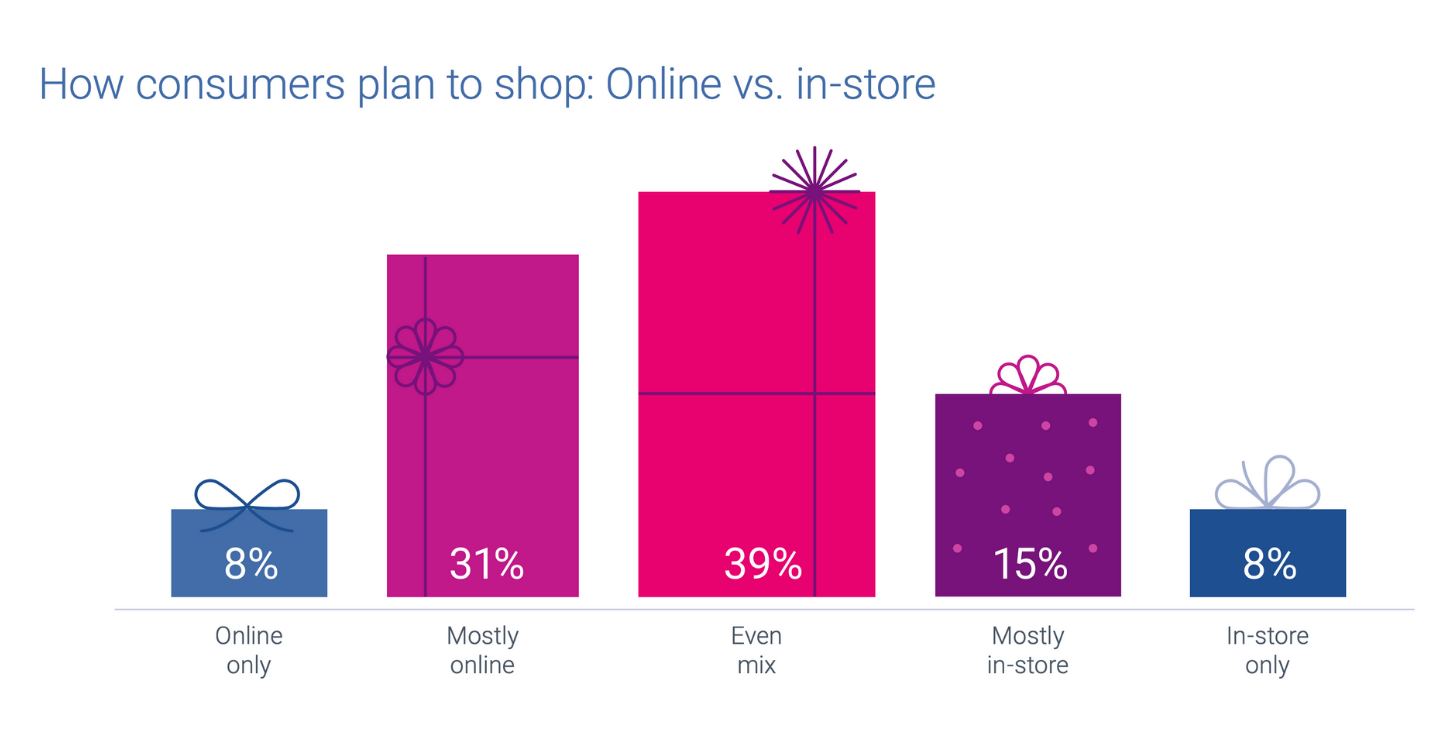
Why it’s complicated
Shoppers love the convenience of browsing online, but they still want the reassurance of seeing, touching, or testing products before buying. In-store isn’t just about the transaction, it’s the validation step.
What to do about it
- Build omnichannel strategies that connect digital discovery with in-store follow-through.
- Use location and identity data to tie digital impressions to real-world actions, like foot traffic and purchases.
- Focus on consistency: shoppers expect the same value, tone, and trust whether they’re on a website, in an app, or standing in a store aisle.
How Duke Cannon used on-premise targeting to drive sales lift
Duke Cannon, a premium men’s grooming brand, partnered with GroundTruth to launch a successful multichannel campaign utilizing location-based and behavioral audience targeting across CTV and mobile screens to drive in-store visits and sales.
By targeting consumers with mobile ads while they were physically in-store, the company capitalized on high purchase intent, aiding in the 12% sales lift. This strategic approach resulted in over 43.9k provable in-store visits and a significant increase in sales.
3. Marketers double down, consumers hold back
This holiday season, expectations are split. 66% of marketers expect holiday spend to rise, but only 22% of consumers agree. While brands are leaning into bigger investments across CTV, retail media, and social, shoppers are staying cautious, weighing value and waiting for the right deal.
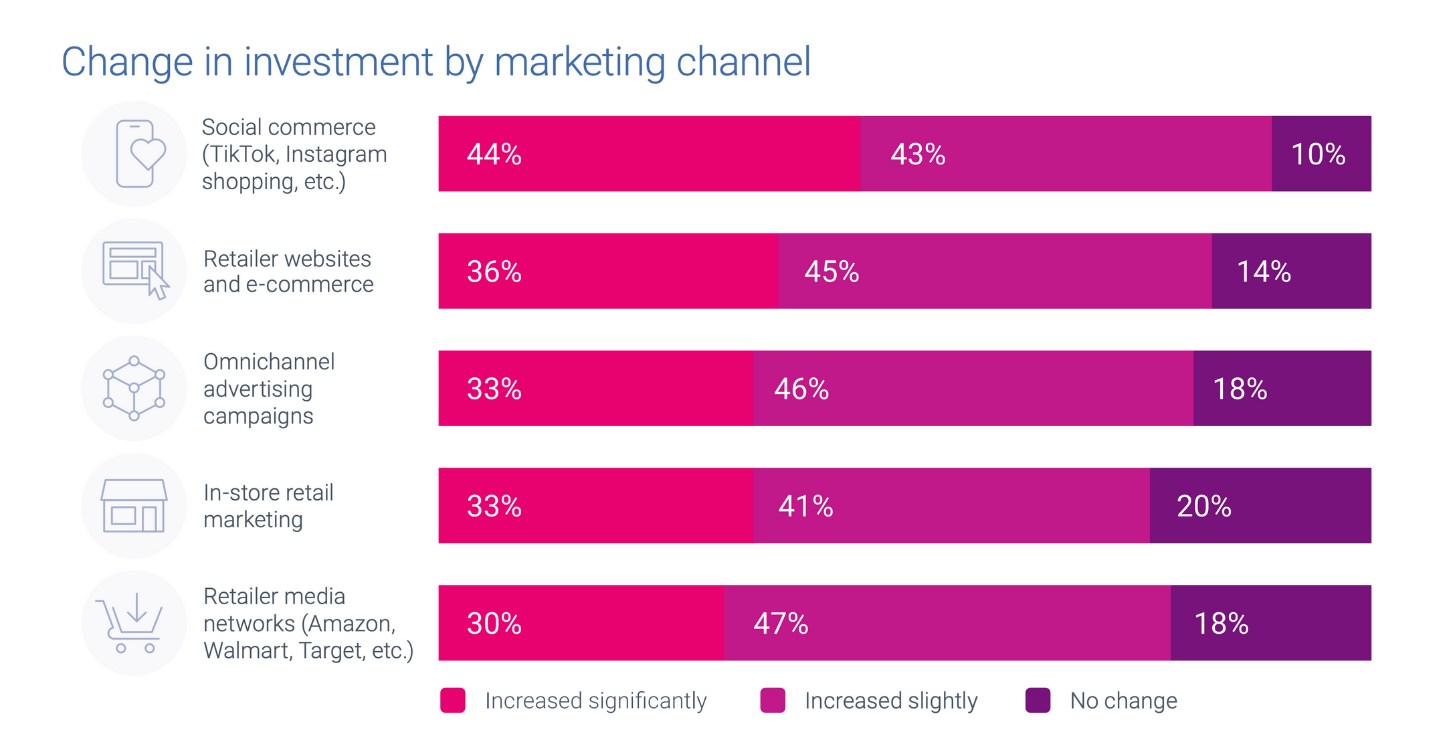
Why it’s complicated
That disconnect introduces risk. If marketers don’t align spend with real consumer behavior, budgets can get wasted in the rush to cover every channel. Shoppers haven’t stopped spending, but they’re spending differently. They’re trading down to discount and big-box retailers while cutting back in discretionary categories like apparel and restaurants.
What to do about it
- Prioritize efficiency by focusing on the right audiences, not just more impressions.
- Make consistency your advantage: reach people once and connect across platforms instead of chasing fragmented signals.
- Balance aggressive media investment with messaging that acknowledges consumer caution — shoppers want value and trust, not hype.
Measuring TV and streaming impact with iSpot
iSpot’s Audience Builder, powered by Experian’s Marketing Attributes, helps brands reach high-value audiences. During the holiday season, a luxury retailer could target $100K+ households with affluent lifestyle interests. With iSpot’s Unified Measurement platform, they can track performance across linear TV and streaming and shift spend in real time to maximize results.
The bottom line on 2025 holiday shopping trends
This year’s holiday shopping season is, well…complicated. Shoppers are cautious but still engaged. They’re early planners and last-minute browsers. They want the ease of digital, but the confidence of in-person.
For marketers, the opportunity lies in embracing that complexity, not trying to simplify it away. The brands that balance relevance, trust, and convenience across the full season and across every channel will be the ones that win.
Download our full 2025 Holiday spending trends and insights report to explore all five shifts shaping this season and see how you can turn complexity into opportunity.
About the author

Fred Cheung
Director, Partnership Sales, Audigent, a part of Experian
Fred Cheung has spent over a decade in the programmatic advertising space, with roles at Mindshare, Jounce Media, Twitter, and The Trade Desk. His deep experience in trading and product management helps in his current function on the Experian Marketing Services’ Sales team where he focuses on data growth and adoption across the industries’ leading buy-side platforms.
2025 holiday shopping trends FAQs
Because consumer behavior is full of contradictions. People will shop earlier but also later, browse online but purchase in-store, and want deals while demanding trust. Marketers need to navigate these push-and-pull dynamics.
Nearly half (45%) say they’ll start before November, but 62% admit they’ll still be buying in December, with momentum even continuing into January through gift card redemptions and deal-hunting.
Although many consumers begin online, the majority still make their final decisions in-store. In-person shopping acts as a validation step where customers can see, touch, or try products before buying.
Instead of focusing only on Black Friday or Cyber Week, marketers should stretch campaigns across the full season, refresh offers frequently, and continue promotions into January.
Not entirely. 66% of marketers expect spending to rise, but only 22% of consumers agree. Shoppers are cautious, prioritizing value and often trading down to discount or big-box retailers.
An omnichannel approach using identity and location data can bridge digital impressions with real-world actions like store visits and purchases, ensuring consistency across touchpoints.
Brands like belVita and Duke Cannon successfully tied digital campaigns to in-store results by utilizing precise audience targeting, location data, and well-timed promotions.
You can download Experian’s 2025 Holiday spending trends and insights report to explore all five shifts shaping this season.
Latest posts

It's almost the start of a new year, so it's time to plan your marketing strategy. One-third of U.S. adults planned to make a New Year's resolution in 2024, with adults under 30 being the most likely to do so. From living healthier lifestyles to traveling more often, there is an opportunity to capture customers with well-targeted messaging. But how do you know which audiences are most interested in these goals? In this blog post, we’ll reveal audience segments designed for you to reach the most relevant shoppers for your New Year’s resolutions campaigns according to shoppers' goals and resolution categories. You can find the complete audience segment name in the appendix. Start the year strong with Experian's audience insights With the New Year almost upon us, it’s the perfect time for a fresh start. Utilize Experian’s syndicated audiences to ensure your marketing messages resonate with your ideal customers. Experian’s 2,400+ syndicated audiences are available directly on over 30 leading television, social, programmatic advertising platforms, and directly within Audigent for activation within private marketplaces (PMPs). Reach consumers based on who they are, where they live, and their household makeup. Experian ranked #1 in accuracy by Truthset for key demographic attributes. Access to unique audiences through Experian’s Partner Audiences available on Experian’s data marketplace, within Audigent for activation in PMPs and directly on platforms like DirectTV, Dish, Magnite, OpenAP, and The Trade Desk. Five New Year's resolution audience categories to embrace this new year There are many different types of New Year's Resolutions that people set come January 1st. Here are five common New Year's Resolutions: Healthy habits Get organized Explore new experiences Live life to the fullest New Year’s budgeteers Let's break down each resolution category and which audiences you can use to target consumers based on their New Year’s resolutions. Healthy habits A significant portion of consumers set their sights on adopting healthier lifestyles and maintaining newfound habits. Target audiences could include those who have recently purchased gym memberships and are shopping at health stores, demonstrating a commitment to their resolutions. Here are five audience segments that you can activate to target consumers focused on healthy habits in the new year: NEW! New Year's Health/Fitness/Gym Membership Shoppers NEW! Frequent Gym Goers Vitamins/Supplements Shoppers New Year's Food/Healthy Food Shoppers New Year's Vitamins/Diet Supplement Shoppers By strategically targeting these segments, your marketing efforts are more likely to resonate with those determined to make a year of lasting, healthy change. Get organized Many consumers pledge to declutter and get organized. One key target audience could consist of those who have recently purchased organizational tools or storage solutions. Additionally, consider reaching out to homeowners or individuals in the midst of a major life change, such as moving or expanding their families, as they often seek ways to simplify and organize their spaces. Here are seven audience segments that you can activate to target consumers focused on getting organized in the new year: NEW! Furniture and Home Decor: Deals Discounts Affordable High Spend Spenders Shoppers NEW! Post Holiday Shoppers Household Goods: Frequent Spenders Home Improvement/DIY: Frequent Spenders Furniture & Home Decor In Store: Frequent Spenders Garden & Landscaping Stores: Frequent Spenders Hardware & Home Improvement Stores: In Store Frequent Spenders To expand or reach new audiences, you can layer in purchase predictors to reach those who are likely to spend on home maintenance and improvement products or are expanding their families. Home Maintenance and Improvement Explore new experiences Many consumers want to embark on a journey of self-improvement by exploring new experiences, whether it's picking up a new hobby or visiting a place they've never been. One primary target audience could be vacation and leisure travelers, as they often seek new destinations and opportunities to make the most of their seasonal getaways. Additionally, sports enthusiasts are always looking to boost their outdoor adventures through fresh experiences and specialized equipment. Here are six audience segments that you can activate to target consumers focused on exploring new experiences in the new year: Play Golf Pickleball Enthusiast Wilderness Sports and Camping Enthusiasts Activities: Camping Summer Airline Travel Summer Travel: Vacation/Leisure Live life to the fullest A considerable number of individuals make resolutions aimed at embracing life to the fullest. One prime target audience includes those who have recently booked travel experiences or adventures, showcasing their commitment to exploring new horizons. Additionally, consider reaching out to individuals who are likely to visit sports stadiums and arenas. Here are seven audience segments that you can activate to target consumers focused on living life to the fullest in the new year: NEW! Budget Savvy Air Travelers Air Travel: Frequent Spenders Cruises: Frequent Spend NFL Stadium Visitors Ski Resort Visitors Vacation/Leisure Travelers: Weekend Getaways Culinary Experience To expand or reach new audiences, you can layer in purchase predictors to reach consumers who are likely to spend on travel and travel-related products. Travel New Year's budgeteers As the new year begins, many consumers are rethinking their finances and seeking smarter ways to spend and save. These audiences are focused on achieving their financial goals by utilizing budgeting tools, finding flexible payment options, and taking control of their debt. With financial wellness top of mind, they are ready to explore solutions that align with their resolution to be more financially savvy. Here are seven key audience segments that reflect the mindset of consumers eager to make 2024 a year of financial empowerment: In market for Buy Now Pay Later In market for Mortgage Refinance In market for Auto Loan Refinance Credit Card High Utilization Likely to Transfer Credit Card Balance Loyal Rewards Enthusiast, Low Credit Card Balance Secure, Savvy Credit User, High Home Equity Balance We can help you reach consumers in the new year Connect with consumers pursuing their New Year's resolutions to kick off 2025. Whether your audience seeks to embrace healthy habits, get organized, explore new experiences, budget their personal finances, or live life to the fullest, Experian Marketing Data provides a solid foundation for targeting, enrichment, and activation As we get ready for 2025, let the power of Experian’s data-driven insights guide your marketing strategies, helping consumers turn their resolutions into reality. Connect with our audience team Need a custom audience? Reach out to our audience team and we can help you build and activate an Experian audience on the platform of your choice. Additionally, work with Experian’s network of data providers to build audiences and send to an Audigent PMP for activation. You can activate our syndicated audiences on-the-shelf of most major platforms. For a full list of Experian’s syndicated audiences and activation destinations, download our syndicated audiences guide. Explore our other seasonal audiences that you can activate today. View now Contact us Appendix Here are the complete audience segment names (taxonomy path) for all audience segments discussed in this blog post. Healthy habits NEW! Retail Shoppers: Purchase Based > Seasonal > New Year's Health/Fitness/Gym Membership Shoppers NEW! Retail Shoppers: Purchase Based > Health and Fitness > Frequent Gym Goers Retail Shoppers: Purchase Based > Health and Fitness > Vitamins/Supplements: Vitamins/Supplements Retail Shoppers: Purchase Based > Seasonal > New Year's Food/Healthy Food Shoppers Retail Shoppers: Purchase Based > Seasonal > New Year's Vitamins/Diet Supplement Shoppers Get organized NEW! Retail Shoppers: Purchase Based > Home Furnishings > Furniture and Home Decor: Deals Discounts Affordable High Spend Spenders Shoppers NEW! Retail Shoppers: Purchase Based > Seasonal > Holiday Shoppers: Post Holiday Shoppers Purchase Transactions > Household Goods > Frequent Spenders Purchase Transactions > Home Improvement/DIY > Frequent Spenders Retail Shoppers: Purchase Based > Home Improvement & DIY > Furniture & Home Decor In Store: Frequent Spenders Retail Shoppers: Purchase Based > Home Improvement & DIY > Garden & Landscaping Stores: Frequent Spenders Retail Shoppers: Purchase Based > Home Improvement & DIY > Hardware & Home Improvement Stores: In Store Frequent Spenders Purchase Predictors > Shoppers All Channels > Home Maintenance and Improvement Explore new experiences Lifestyle and Interests (Affinity) > Activities and Entertainment > Play Golf Retail Shoppers: Purchase Based > Sporting Goods, Apparel > Pickleball Enthusiast Retail Shoppers: Purchase Based > Outdoor Activities > Wilderness Sports and Camping Enthusiasts Travel Intent > Activities > Camping Retail Shoppers: Purchase Based > Seasonal > Summer Airline Travel Retail Shoppers: Purchase Based > Seasonal > Summer Travel: Vacation/Leisure Retail Shoppers: Purchase Based > Travel > Vacation/Leisure Travelers: Summer Trips Live life to the fullest NEW! Retail Shoppers: Purchase Based > Seasonal > Budget Savvy Air Travelers Retail Shoppers: Purchase Based > Travel > Air Travel: Frequent Spenders Retail Shoppers: Purchase Based > Travel > Cruises: Frequent Spend Mobile Location Models > NFL Stadium Visitors Mobile Location Models > Ski Resort Visitors Retail Shoppers: Purchase Based > Travel > Vacation/Leisure Travelers: Weekend Getaways Travel Intent > Activities > Culinary Experience Purchase Predictors > Shoppers All Channels > Travel New Year’s budgeteers Financial > In Market > Buy Now Pay Later Financial FLA Friendly > In Marketing Mortgage Refinance Financial FLA Friendly > In Market Auto Loan Refinance Financial FLA Friendly > Credit Card High Utilization Financial FLA Friendly > Likely to Transfer Credit Card Balance Financial Personalities > Credit Card Financial Personality > Loyal Rewards Enthusiast, Low Credit Card Balance Financial Personalities > Home Equity Financial Personality > Secure, Savvy Credit User, High Home Equity Balance Latest posts
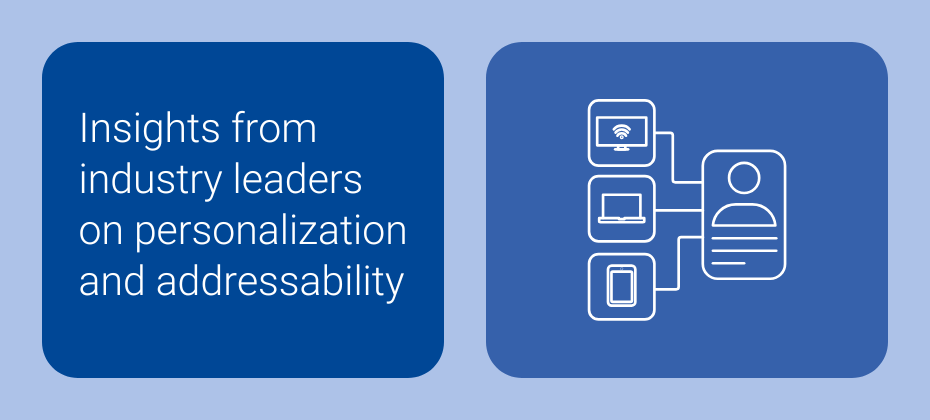
Brands are increasingly focused on offering personalized experiences while respecting consumer privacy. Addressability enables them to reach specific audiences with relevant messages, and personalization crafts unique content that aligns with each audience's interests and needs. By combining these strategies, brands can create more relevant and effective marketing campaigns. With new regulations and signal loss reshaping the landscape, alternative identifiers like the ID5 ID and The Trade Desk's Unified I.D. 2.0 (UID2) are gaining importance. These tools give advertisers a more holistic view of consumers across channels, enhancing personalization and addressability even as traditional third-party cookies lose relevance. To shed light on this topic, we interviewed experts from Audigent, Basis Technologies, CvE, ID5, MiQ and others. They shared insights on navigating privacy, utilizing new identifiers, and enhancing personalization with consent. Drawing from their perspectives, we've identified five considerations to help brands adapt and succeed in this evolving landscape. 1. Embrace a privacy-centric approach With the increasing focus on consumer data protection, prioritizing privacy in your addressability efforts is essential. Implement strict data guidelines to protect personally identifiable information (PII) and maintain compliance with state-specific regulations. To achieve this, empower consumers by providing clear and transparent choices about data sharing and honoring their preferences. Avoid targeting based on protected categories or sensitive information. By adopting a privacy-first mindset, you can build consumer trust while still delivering relevant advertising experiences. “It's important to champion consumer privacy and the free internet. We need to strike a balance between the two. This balance is essential for our jobs, the economy, news, politics, and all the valuable content and information we rely on.”Drew Stein, Audigent 2. Personalize with consent Consumers are more willing to share their information when they see clear benefits. In fact, over half of shoppers—and two-thirds of Gen X and Millennials—express a desire to receive holiday shopping deals directly from their preferred brands1. By offering value through loyalty programs, special offers, or interactive platforms, you can personalize experiences without compromising privacy. To implement this strategy, encourage consumers to share their preferences and needs by being transparent and giving them control over their data. This approach builds trust, empowers your audience, and enhances personalization. “Building personalization based on the data consumers have consented to share should lead to a positive experience that drives better engagement because it's relevant to them.” April Weeks, Basis Technologies 3. Personalize with contextual targeting Contextual targeting involves delivering ads based on the content users are currently engaging with rather than user identifiers. By focusing on personalization through contextual targeting and dynamic content, you can align your strategies with your audience's real needs and interests. This approach allows advertisers to reach consumers on websites with more visitors matching the demographics, behaviors, or interests they want to target. “Personalization absolutely can thrive. We have various solutions, all utilizing IDs for targeting and personalization. Beyond that, we can also personalize using context, geo-contextual data, and creative strategies.” Georgiana Haig, MiQ 4. Use alternative identifiers As advertisers move beyond third-party cookies, exploring alternative identifiers offers reliable means to connect with consumers. Options like email addresses or device IDs provide direct connections, improving targeting accuracy. Utilize identity graphs to link different signals and identifiers to establish strong ties to individual users or households. This approach maintains, and can even enhance, your ability to reach the right audience and measure campaign performance. “It's not just about maintaining addressability. It's about massively improving addressability. When we run tests with some of our clients, they're seeing 30, 40, 50, 60% incremental reach by using ID5 versus cookies.” Mathieu Roche, ID5 5. Build partnerships Navigating the complexities of addressability doesn't have to be a solo effort. Partnerships between brands, publishers, and tech providers can lead to innovative solutions that benefit everyone. Consider engaging in data partnerships to access new audience segments without maintaining extensive data. Collaborations focused on your tech stack can enhance your ability to deliver personalized content effectively and at scale. “The rise of second-party data partnerships is going to be an interesting trend over the next couple of years. And if you need mass scale across the world, I think that's a much more cost effective and scalable way to do it.” Paul Frampton, CvE Steering toward success The future of addressability and personalization hinges on your ability to adapt to the changing privacy landscape while delivering meaningful, personalized experiences. By focusing on these five key considerations, you can navigate the complexities of modern advertising, build stronger relationships with consumers, and drive sustainable growth. Connect with our addressability experts Footnote Online survey conducted in June, 2024 among n=1,000 U.S. adults 18+. Sample balanced to look like the general population on key demographics (age, gender, household income, ethnicity, and region). Latest posts

Originally appeared on VideoNuze Connected TV (CTV) is a leading platform in digital advertising, combining the precise targeting of digital ads with the broad reach and storytelling power of traditional TV. This creates an immersive experience that offers full-funnel marketing results. As consumer time spent watching CTV has doubled over the past five years and linear TV viewing patterns have shifted, advertisers now see CTV as essential for reaching and engaging audiences. Of those CTV users, viewers increasingly choose to watch content with ads. By 2025, free ad-supported streaming TV (FAST) viewers will increase to 49% of CTV users, further highlighting the opportunity for marketers to captivate audiences in ways standard digital display ads can't match. With the explosion of consumer time spent and advertising dollars following, making CTV more addressable and targeted requires a combination of identity and audience. Historically, the IP address has been the most popular way to target a household with a CTV (e.g., LG, Samsung, Vizio device) or streaming platform (e.g., Disney+, Paramount+, Roku, Amazon Prime, etc.). As IP addresses continue to fluctuate in terms of durability, consistency, and type, including the increased adoption of IPv6, we have seen a new incumbent enter the CTV ecosystem: Unified ID 2.0 (UID2). UID2 stands out as a particularly valuable tool for CTV advertisers. It provides a standardized way to identify and target users across CTV and traditional channels like display and mobile while respecting consumer privacy. Given that purchases might not occur on CTV, UID2's ability to link ad exposure on CTV to conversions on other devices is crucial for demonstrating a CTV campaign's true impact. Authenticated audiences are key to CTV's appeal A significant advantage of CTV is its high rate of logged-in, authenticated users. This provides marketers with reliable first-party data for targeting and measurement purposes. UID2 benefits from this since it's a universal identifier based primarily on first-party data, such as people’s email addresses and phone numbers. Authenticated viewers can also be connected across different devices, enabling marketers to understand the full customer journey, which helps attribute conversions more accurately to CTV ads. Key advantages of CTV for digital marketers Superior viewing experience: Larger screens and a captive audience watching high-quality on-demand content Authenticated users: Enables precise audience targeting, more personalized ad experiences, and enhanced cross-device attribution Value exchange: Viewers get cost-effective content with personalized ads, leading to higher engagement "Authenticated viewers and universal IDs like UID2 are revolutionizing CTV advertising, enabling the effective delivery of personalized content and ensuring strong engagement for marketers; Paramount is committed to optimizing across platforms and will continue to utilize tools and advancements that maximize reach for our partners and improve the user experience for our viewers."Travis Scoles, Executive Vice President, Paramount Advertising The role of universal IDs in CTV advertising Universal IDs, like UID2, play a critical role in CTV by ensuring consistent user identification across platforms while respecting privacy. Adoption of UID2 is gaining traction in the TV industry, with brands such as AMC Networks, Disney, Dish Media, FreeWheel, NBCUniversal, Roku, and Paramount integrating it into their digital advertising ecosystem. As authentication increases across traditional digital and mobile apps, especially CTV, universal IDs like UID2 enable cross-device and cross-channel identity strategies without cookies. This is especially important as traditional identifiers like third-party cookies and IP addresses face an uncertain future. Better understand and reach your audience with identity graphs For CTV ad spending to catch up to time spent with CTV, the industry must use these authenticated signals and universal IDs. Identity graphs, like Experian’s, integrate various identifiers (e.g., universal IDs, CTV IDs, IP addresses), allowing CTV platforms to understand relationships between households, individuals, and devices. This understanding enables: Publishers using universal IDs can make advertising on their platform more addressable, which will lead to higher demand. Marketers can achieve greater precision with cross-device targeting, cross-channel frequency management, and more holistic measurement since conversions often happen on non-CTV devices. Viewers receive a more personalized ad experience (without seeing the same ad repeatedly), which will increase engagement with a marketer's campaign. Watch our Ask the Expert video with The Trade Desk to deepen your knowledge on CTV advertising and UID2. Watch the video here Contact us Latest posts